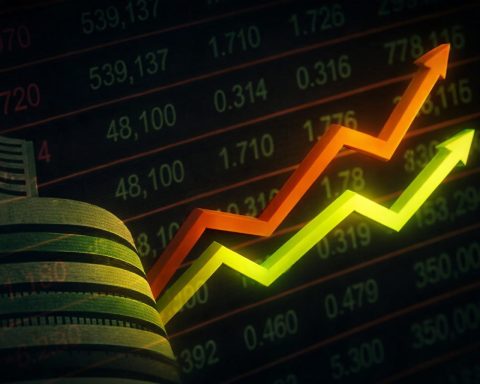- EUR/USD breakout: Euro surged on Oct 15–16, rising ~0.34% as the US dollar weakened. TechStock² reports the USD index fell ~0.36% while EUR/USD climbed to about $1.1645 [1]. Analysts note this rally was fueled by dovish Fed talk (Fed Gov. Bowman still expects “two more cuts” this year [2]) and political stability in Europe [3].
- Day-trading tactics: Retail traders “nailed” the EUR/USD moves by combining key intraday levels and patterns [4] [5]. TradeThatSwing’s Cory Mitchell highlighted classic setups – e.g. range breakouts and retests – calling the first breakout entry on Oct 15 “A1 bread and butter” [6]. He emphasized following “range rules” and tight 2.5-pip stops for 5-pip targets to match the day’s low volatility [7] [8].
- Stocks & sentiment: U.S. stocks were broadly higher mid-week (S&P 500 +0.4%, Nasdaq +0.7% on Oct 15 [9]) on strong tech and bank earnings. Strategists grew more bullish; TS2.tech notes some now project the S&P 500 could hit the 6,000–7,000 range by 2026 [10]. However, credit worries late-week trimmed gains – by Oct 16 the Dow, S&P and Nasdaq were each down roughly 0.5–0.7% [11].
- Safe havens: Banking jitters sent buyers flocking to gold and Treasuries. Gold futures hit new highs (~$4,300/oz) [12] (TL; safe-haven rallies, TS2 noted gold “topped $4,200” and oil tumbled to ~5-month lows [13]). U.S. 10-year yields slid to ~3.97% (a ~3-year low) as traders priced in Fed cuts [14] [15].
- Trader community: A Business Insider survey finds many Gen-Z/Millennial day traders feel isolated. TraderEdu CEO Daniel Alhanti calls trading “a very lonely sport,” likening it to solo sports like tennis or poker [16]. His observation is borne out in the data: Google searches for “day trading group” have spiked about +572% recently [17], as traders seek camaraderie and shared learning.
Market overview: Risk-on after Fed hints.
Global markets were buoyed mid-week by better-than-feared news. U.S. bank and tech earnings beat estimates, sending all three U.S. indexes higher on Oct 15 [18]. TechStock² reports the S&P 500 and Nasdaq set new all-time highs, helped by Morgan Stanley, Bank of America and Salesforce beating forecasts [19] [20]. Luxury stocks also jumped (LVMH +14%) on Chinese demand signs [21].
In currency markets, the U.S. dollar weakened markedly. TS2.tech notes the Dollar Index fell to ~98.7, and EUR/USD rose to ~$1.1645 as Fed officials (like Gov. Bowman) reiterated expectations of further easing [22]. Convera’s Oct 17 report agrees, pointing out that EUR/USD has “rebounded nearly 1% this week” to levels near 1.18, bolstered by France’s newfound political stability and dovish Fed tone [23] [24]. U.S. inflation and shutdown worries have lifted fed fund futures, which now fully price in quarter-point cuts on Oct 28–29 and Dec 16 [25]. As one Reuters Fed-watcher noted, “as long as we see the labor market and other data evolving…we will continue to be on a path for lowering the federal funds rate” [26].
This “risk-on” backdrop drove gold and bonds up. Spot gold has crossed $4,300/oz – record territory – on safe-haven demand [27]. Oil, by contrast, is languishing near 5-month lows (WTI ~$57.5) as traders fret over a possible demand slowdown [28] [29]. TS2 observes the correlation: “The dollar was broadly weaker…A softer dollar came amid comments that the Fed may ease policy further” [30], which in turn helped gold and other havens set new highs [31].
EUR/USD day trades: key levels and scalping.
Retail day traders on Oct 15 capitalized on EUR/USD’s moves by sticking to high-probability setups. As Vladimir Popescu at Watcher.Guru reports, the pair formed clear technical structures at horizontal support/resistance levels. When the euro broke down from a choppy morning range, traders waited for a retest of the old support (now resistance) before entering shorts [32]. Mitchell himself praised this setup as “exactly what you want to see” [33]. The consensus approach was very cautious – using ~2.5-pip stops with ~5-pip profit targets – reflecting the day’s subpar 5–6 pip swings [34] [35]. In a second move, when EUR/USD spiked back into the prior range, a confirmed breakout (above the key candle high) prompted a long. Again Mitchell says “range rules apply” – wait for a clean break, then enter [36].
A third “bread-and-butter” signal came at a rounded top near the established resistance zone [37]. Here traders shorted on a tight break of a key candle low. As Mitchell reminds us, “all trades are probabilities” – high-confidence setups like this typically have 60–70% win rates [38], whereas gambling on ambiguous moves does not. In sum, the Oct 15 session “proved that successful EUR/USD day trades come from combining technical patterns with meaningful horizontal levels while respecting the day’s actual conditions” [39]. Traders stuck to what the market gave – small-range scalping rather than forcing big swings – and that disciplined focus “nailed” the day’s EUR/USD opportunities [40] [41].
Cory Mitchell of TradeThatSwing emphasizes this disciplined approach. In a video recap (Oct 15), he highlights the use of “Range Rules or key levels” to pick entries [42]. He warns traders to account for spread costs and to “avoid low-quality trades,” even if such trades might occasionally win in the short run. By aligning trades with clear patterns and targets, traders can capture small moves predictably. For example, Mitchell notes that forcing a short in a messy zone is “not as clean…that’s more gambling,” whereas waiting for the textbook pullback “is exactly what you want to see” [43].
Global markets and analysts’ view.
Despite the dip in U.S. equities on Oct 16, many analysts remain broadly optimistic. TechStock² cites analysts who see the mid-October rally as evidence that “corporate profits and possibly easier monetary policy can overcome geopolitical risks” [44]. Pepperstone strategist Michael Brown argues the “longer-run path of least resistance continues to point firmly to the upside” for equities [45]. Wall Street strategists have even hiked year-end targets – TS2 notes some are eyeing S&P 500 levels in the 6,000–7,000 range by 2026 [46].
That said, new headwinds have emerged. U.S. regional bank stocks tumbled after reports of loan losses, dragging on financials. European markets opened sharply lower on Oct 17 as lenders plunged (the STOXX 600 fell ~1.5%, led by Deutsche Bank, Barclays, BNP) [47]. Analysts caution that hidden credit stress is now a risk: IG’s Tony Sycamore points out that post-2023 crisis fixes have “created a tinderbox for another banking flare-up” [48]. In Asia, the spillover saw Japan’s Nikkei drop ~1.5% and financials slumped [49]. The dollar’s downtrend continued – Reuters notes USD index ~98.10 on Oct 17 [50] – which means further upside for EUR/USD if no fresh crisis erupts.
Forex outlooks align with this view. A Reuters poll (early Oct) had forecasters expecting the dollar to weaken further; the median survey predicted EUR/USD near 1.19 by year-end and ~1.21 in a year [51]. Convera’s FX analysts, however, advise caution: they point out that for EUR/USD to break to new multi-year highs (~1.1919), a significant U.S. data setback or geopolitical shock would likely be needed [52]. For now, with two Fed cuts already priced in, Convera sees the ECB-fueled euro rally capped around the 1.18 area [53] [54].
In commodities, the picture is mixed. Gold’s rally may continue if global uncertainties mount – it’s already up ~8.5% this week, the best weekly gain since Lehman in 2008 [55]. Oil, however, could face headwinds: U.S. President Trump hinted at tougher import rules for soy/cooking oil, pressuring energy and agricultural stocks (see Pinnacle Foods’ 139% spike on Oct 15 [56]). China trade tensions (e.g. rare-earth export curbs) and the U.S. shutdown also loom large on investor minds.
The human side: ‘A very lonely sport’.
Behind these market moves, a social trend is emerging: day trading has become unexpectedly communal. Business Insider interviewed dozens of young traders, who universally describe it as isolating “solo” work [57] [58]. As Alhanti remarks, traders often feel like “professional poker players” – constantly in a room by themselves [59]. This has driven an explosion in online and in-person trading groups. Alhanti’s own TraderDaddy group has seen surging interest recently, and he now hosts nightly Zoom calls and Manhattan meetups for members [60]. In fact, Google Trends shows searches for “day trading group” up ~572% in the past quarter [61]. Platforms like BullMentor (founded by ex-lonely trader Melissa Avutan) have also popped up to connect traders with coaches and peers.
Traders say the peer networks help bridge the gap. As one 20-year-old trader put it, he accepts “being lonely was simply part of the deal” for a while [62], but over time the community aspect is changing. Alhanti’s goal is to transform trading from “something you do by yourself” into “a team sport” [63]. This shift suggests that alongside the technical strategies and market forecasts, the very culture of trading is evolving in 2025.
Sources: Market data and expert commentary are drawn from Reuters, Investopedia, TechStock² (TS2.tech), and financial media. Trade analysis quotes are from TradeThatSwing’s Cory Mitchell [64] and Watcher.Guru [65] [66]. Day-trader community insights come from Business Insider’s Oct 2025 feature [67] [68]. All figures (index moves, prices) are as of mid-Oct 2025.
References
1. ts2.tech, 2. ts2.tech, 3. convera.com, 4. watcher.guru, 5. watcher.guru, 6. watcher.guru, 7. watcher.guru, 8. watcher.guru, 9. ts2.tech, 10. ts2.tech, 11. www.investopedia.com, 12. www.investopedia.com, 13. ts2.tech, 14. www.investopedia.com, 15. www.reuters.com, 16. www.businessinsider.com, 17. www.businessinsider.com, 18. ts2.tech, 19. ts2.tech, 20. www.investopedia.com, 21. ts2.tech, 22. ts2.tech, 23. convera.com, 24. convera.com, 25. ts2.tech, 26. ts2.tech, 27. www.investopedia.com, 28. ts2.tech, 29. www.investopedia.com, 30. ts2.tech, 31. ts2.tech, 32. watcher.guru, 33. watcher.guru, 34. watcher.guru, 35. watcher.guru, 36. watcher.guru, 37. watcher.guru, 38. watcher.guru, 39. watcher.guru, 40. watcher.guru, 41. watcher.guru, 42. tradethatswing.com, 43. watcher.guru, 44. ts2.tech, 45. ts2.tech, 46. ts2.tech, 47. www.reuters.com, 48. www.reuters.com, 49. www.reuters.com, 50. www.reuters.com, 51. www.reuters.com, 52. convera.com, 53. convera.com, 54. convera.com, 55. www.reuters.com, 56. ts2.tech, 57. www.businessinsider.com, 58. www.businessinsider.com, 59. www.businessinsider.com, 60. www.businessinsider.com, 61. www.businessinsider.com, 62. www.businessinsider.com, 63. www.businessinsider.com, 64. tradethatswing.com, 65. watcher.guru, 66. watcher.guru, 67. www.businessinsider.com, 68. www.businessinsider.com










